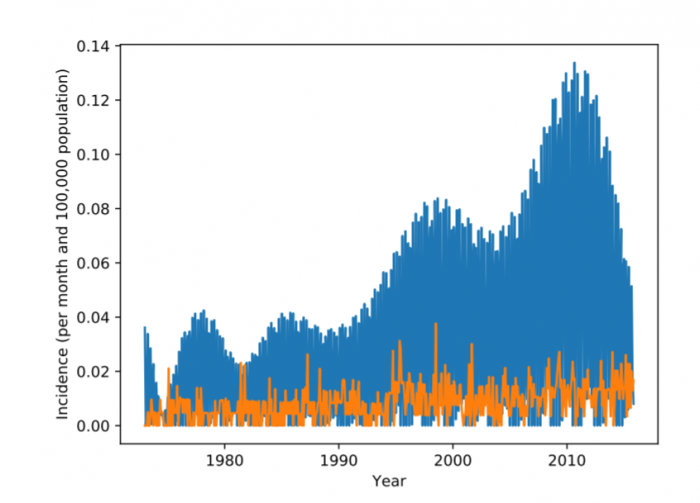Does dark matter really cause skin cancer? Have a guess.

Most cosmologists believe our universe is filled with strange invisible stuff that exerts a powerful gravitational force on a galactic scale. This force stops galaxies from tearing themselves apart as they rotate.
But so-called dark matter ought to have other effects. Earth, for example, must by swimming in a huge ocean of dark matter. And from time to time, a lump of it ought to smash into visible matter, leaving a telltale sign that we ought to be able to detect, such as vibrations that increase the temperature by a small amount.
Physicists are engaged in a multibillion-dollar race to detect these effects. The winner—the putative discoverer of dark matter—is set to win the kind of scientific fame and fortune that only a few scientists ever enjoy.

This search has led others to think about the possible effects of dark matter too, and earlier this year Konstantin Zioutas from the University of Patras in Greece and Edward Valachovic at the State University of New York at Albany published their theory in the journal Biophysical Research Letters.
These guys studied the rates of skin cancer in the US between 1973 and 2011 and found an unexplained annual periodicity and a much shorter 88-day periodicity. In other words, the rate of skin cancer diagnosis varies in regular annual cycles and in regular 88-day cycles. That’s a curious observation.
But even stranger is the idea Zioutas and Valachovic put forward to explain it. These guys’ theory is that dark matter causes skin cancer by damaging the DNA it bumps into. They go on to say that the sun and planets can focus dark matter as they move through it. And whenever Earth passes through one of these focused streams of dark matter, skin cancer rates rise.
The icing on this theoretical cake is that the observed periodicities exactly match the orbital periods of Earth and Mercury, so all the pieces fall neatly into place.
That’s an extraordinary claim and, of course, one that requires extraordinary evidence.
Today, Hector Socas-Navarro at the Instituto de Astrofísica de Canarias in the Canary Islands, Spain, cast a critical eye over this theory. His withering conclusion is that it is not consistent with the evidence or known science. And this analysis provides an interesting and important prism through which to see the process of science at work.
Socas-Navarro begins with a brief discussion of the basic features that dark matter seems to have (it is itself a hypothesis, of course). For a start, dark matter appears to be more uniformly distributed on interstellar scales than visible matter. “The amount of dark matter mass contained in the solar system is estimated to be comparable to that of a large asteroid,” he says. That’s why it is only important on galactic scales.
But if dark matter is uniformly distributed, it ought to be sweeping through our bodies at speeds of hundreds of kilometers per second as Earth moves through space. It is certainly conceivable that particles of dark matter could collide with human DNA from time to time and even trigger mutations.
But there is significant uncertainty in this kind of thinking. “Given our present lack of knowledge on the [dark matter] properties, it is not possible to estimate the rates of collisions or mutations produced by these particles,” says Socas-Navarro.
Neither is it possible to work out how these rates might vary over time. There is certainly a possibility that the density of dark matter Earth passes through might vary over time scales of tens of millions of years. But Zioutas and Valachovic envisage a scenario in which the motion of planets changes this density. Socas-Navarro valiantly tries to imagine how this might happen.
He imagines that there is a stream of dark matter that Mercury passes in and out of during its orbit round the sun. During each of these orbits, Mercury somehow focuses dark matter toward Earth, and this raises the rate of skin cancer diagnosis.
For this to work, Mercury must dive into this stream at the same point during each orbit over the last 38 years. So the stream of dark matter must have a scale that is comparable with Mercury’s orbit, which is 58 million kilometers across.
But Socas-Navarro cannot ignore the motion of the sun in this model. It moves through the galaxy at a rate of 200 kilometers per second and so has traveled several trillion kilometers through this dark-matter stream in the last 38 years. “This mismatch of several orders of magnitude between both distances makes it nearly impossible to construct a suitable geometrical scenario,” says Socas-Navarro. The sun’s motion could, of course, be exactly aligned with the stream over many trillions of kilometers, but this would be a remarkable and unlikely coincidence.
Then there is the motion of Earth. Even if Mercury were periodically diving in and out of this stream and focusing dark matter toward us, the position of Earth would be different each time. This makes the observed 88-day skin cancer periodicity almost impossible to match with Mercury’s orbital period.
So from an astrophysical point of view, Zioutas and Valachovic’s theory seems doomed.
But the theory suffers from some unfortunate medical shortcomings too. For example, the data set records the time of diagnosis, not the time when the skin cancer begins or when patients first notice symptoms. Various studies show that the time elapsed between first noticing symptoms and receiving a diagnosis is about seven to 11 months.
That kind of variation is hard to reconcile with the dark matter theory. “Diagnosis delay is an important problem in medicine and it would smear out any possible periodic signal that could have existed,” says Socas-Navarro.
Perhaps most damning is the apparent immunity of the black population to skin cancer caused by dark matter. Socas-Navarro points out that skin pigmentation is a well-known protective factor against ultraviolet radiation and skin cancer. “However, there is no known reason why it should protect against dark matter,” he says.
And yet the data shows that the rate of skin cancer in the black population is much lower and does not follow the same periodicities as the white population. Again, that is hard to reconcile with the dark matter theory. “There is no known reason why a darker skin should make people immune to dark matter,” says Socas-Navarro.
Clearly, the evidence is not consistent with the idea that dark matter causes skin cancer.
So what might explain the periodicities observed by Zioutas and Valachovic? “The one-year period and its harmonics found in most types of cancer are probably a direct consequence of our medical examination habits,” says Socas-Navarro. In other words, annual periodicities are probably linked to the fact that people tend to get annual health check-ups.
However, the 88-day periodicity, and another at 70 days that Socas-Navarro points out, remain unexplained.
That’s interesting work by Socas-Navarro who maintains a dignified loyalty to scientific inquiry throughout his paper. Indeed, that’s exactly how science should work: by observation, hypothesis, testing, and rechecking against nature.
Left-field ideas are an important part of the scientific firmament. They are often wrong. But every now and again, they revolutionize our understanding of the universe.
But the way to tell the difference is not through faith or ridicule or aggression or even wishful thinking, but through the process of evidence-based science. Long may it flourish.
Ref: arxiv.org/abs/1812.02482 : On The Connection Between Planets, Dark Matter
Deep Dive
Biotechnology and health
How scientists traced a mysterious covid case back to six toilets
When wastewater surveillance turns into a hunt for a single infected individual, the ethics get tricky.
An AI-driven “factory of drugs” claims to have hit a big milestone
Insilico is part of a wave of companies betting on AI as the "next amazing revolution" in biology
The quest to legitimize longevity medicine
Longevity clinics offer a mix of services that largely cater to the wealthy. Now there’s a push to establish their work as a credible medical field.
There is a new most expensive drug in the world. Price tag: $4.25 million
But will the latest gene therapy suffer the curse of the costliest drug?
Stay connected
Get the latest updates from
MIT Technology Review
Discover special offers, top stories, upcoming events, and more.